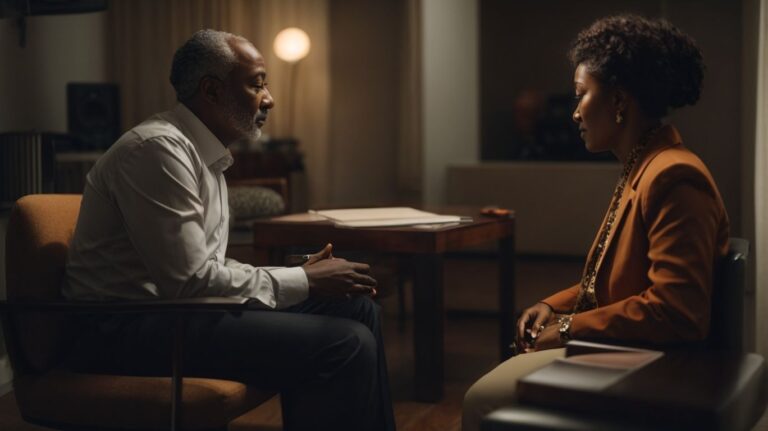Anxiety hierarchy is a valuable tool used in psychology to help individuals overcome their anxieties and phobias. In this article, we will explore the concept of anxiety hierarchy, its applications in psychology, and the benefits it offers.
We’ll also discuss the techniques used in anxiety hierarchy, how to create an anxiety hierarchy, and the limitations of this approach. Whether you’re a psychology enthusiast or someone looking to understand and conquer your own anxieties, this article will provide valuable insights into anxiety hierarchy and its practical implications.
Contents
- 1 Key Takeaways:
- 2 What is Anxiety Hierarchy?
- 3 How is Anxiety Hierarchy Used in Psychology?
- 4 What Are the Benefits of Using Anxiety Hierarchy?
- 5 What Techniques are Used in Anxiety Hierarchy?
- 6 How to Create an Anxiety Hierarchy?
- 7 What Are the Limitations of Anxiety Hierarchy?
- 8 Frequently Asked Questions
- 8.1 What is anxiety hierarchy in psychology and how is it used?
- 8.2 How does understanding anxiety hierarchy help in overcoming anxiety?
- 8.3 What are some common applications of anxiety hierarchy in psychology?
- 8.4 Are there any potential risks or side effects of using anxiety hierarchy in psychology?
- 8.5 Can anxiety hierarchy be used for other mental health conditions besides anxiety disorders?
- 8.6 What are some tips for creating an effective anxiety hierarchy?
Key Takeaways:
- Understanding Anxiety Hierarchy is crucial in the field of psychology to effectively treat anxiety disorders.
- Anxiety Hierarchy helps identify triggers, provides a structured treatment approach, and allows for gradual exposure to anxiety-inducing situations.
- The techniques used in Anxiety Hierarchy include systematic desensitization, exposure therapy, and cognitive restructuring. Creating a personalized hierarchy requires identifying triggers, ranking them, and creating a step-by-step plan for exposure.
What is Anxiety Hierarchy?
An anxiety hierarchy, also known as a fear hierarchy, is a structured list of anxiety-inducing situations or triggers, ranked in order of their potential to evoke fear or anxiety.
It plays a crucial role in the cognitive-behavioral therapy (CBT) for anxiety treatment, serving as a guide for exposure therapy. By systematically confronting these situations in a hierarchical order, individuals gradually desensitize themselves to the feared stimuli, leading to reduced anxiety responses and increased tolerance.
For specific phobias, anxiety hierarchy helps in systematically confronting and addressing the feared stimuli. Whether it is a fear of flying, heights, or public speaking, the hierarchy assists in gradual exposure, leading to desensitization and eventual reduction in anxiety levels.
How is Anxiety Hierarchy Used in Psychology?
In psychology, the use of anxiety hierarchy is integral to anxiety therapy, particularly in systematic desensitization therapy, a cornerstone of behavior therapy, where individuals are exposed to anxiety-causing triggers in a controlled manner to elicit the relaxation response.
What Are the Benefits of Using Anxiety Hierarchy?
Utilizing an anxiety hierarchy in treatment programs offers several benefits, including the identification of triggers, structured exposure to anxiety-inducing situations, and the utilization of relaxation techniques to manage anxiety.
Helps Identify Triggers and Patterns
Anxiety hierarchy aids in identifying individual triggers and patterns associated with anxiety response, enabling the development of effective coping mechanisms and tailored therapeutic interventions.
This structured approach involves systematically ranking anxiety-inducing situations, thoughts, and sensations based on their level of distress, thereby pinpointing specific sources of unease.
By illuminating the underlying factors contributing to heightened anxiety, individuals can then craft personalized coping strategies to address their unique triggers and manage their emotional distress effectively.
This process facilitates the customization of therapeutic interventions to align with the individual’s specific triggers and responses, thereby maximizing the effectiveness of treatment.
Provides a Structured Approach to Treatment
Employing an anxiety hierarchy offers a structured approach to therapy, allowing clients to gradually gain control over their anxiety levels through systematic exposure and targeted interventions.
By utilizing an anxiety hierarchy, therapists can give the power to clients to engage in a systematic process of confronting their fears in a controlled manner. This method assists clients in identifying and ranking their anxiety-inducing situations, subsequently enabling them to address these situations in a hierarchical order.
As clients confront each fear in a methodical manner, they become more adept at managing their anxiety responses and gradually build confidence in their ability to navigate challenging scenarios.
The hierarchy also reinforces the mantra ‘facing fears step by step,’ demonstrating to clients that facing anxiety-inducing situations incrementally can lead to successful outcomes.
It places emphasis on gradual exposure, which prevents overwhelming the client and helps to avoid triggering severe anxiety responses that could hinder progress. This structured approach enhances client give the power toment and fosters a sense of control over their anxiety, ultimately laying the foundation for targeted interventions to be more effective in reducing anxiety levels over time.
Allows for Gradual Exposure to Anxiety-Inducing Situations
The use of anxiety hierarchy enables individuals to engage in gradual exposure to anxiety-inducing situations, facilitating the desensitization of fear responses and promoting mental health resilience.
Exposure through anxiety hierarchy involves systematically facing feared situations in a structured manner, starting with less anxiety-provoking scenarios and moving towards more challenging ones. This regulated approach allows individuals to confront their fears in a manageable way, helping them to adapt and ultimately reduce the intensity of their anxious reactions.
By repeatedly exposing oneself to anxiety triggers, the process of desensitization occurs, enabling individuals to build tolerance and decrease their anxiety levels over time. This practice is pivotal in reshaping negative associations with anxiety-provoking situations and fostering mental resilience.
What Techniques are Used in Anxiety Hierarchy?
Various techniques are employed within anxiety hierarchy, including systematic desensitization, exposure therapy, and cognitive restructuring, each targeting different aspects of anxiety management and behavior modification.
Systematic desensitization, a cornerstone of anxiety hierarchy, involves gradually exposing individuals to their feared stimuli while simultaneously teaching them relaxation techniques. This approach aims to reduce the association between the feared stimuli and anxiety, thus reshaping their behavioral responses.
Exposure therapy encourages individuals to face their fears directly in a controlled setting, helping them to confront and overcome anxiety-provoking situations. Cognitive restructuring focuses on identifying and challenging irrational thoughts and beliefs, replacing them with more rational and positive thinking patterns to alleviate anxiety.
Systematic Desensitization
Systematic desensitization, a key component of anxiety hierarchy, involves the systematic exposure to anxiety-causing stimuli paired with relaxation techniques to elicit the relaxation response through reciprocal inhibition.
This process is based on the principle that it is impossible for an individual to be anxious and relaxed at the same time. By gradually exposing the individual to the feared stimuli while maintaining a relaxed state, the anxiety response diminishes over time as the relaxation response gains strength.
The construction of an anxiety hierarchy, listing anxiety-provoking situations from least to most anxiety-inducing, guides the systematic exposure. It is imperative to commence with the least anxiety-inducing situation and progress systematically. Each step entails achieving a deep state of relaxation before moving to the next, more anxiety-provoking stimuli.
Exposure Therapy
Exposure therapy, a fundamental aspect of anxiety hierarchy, involves the deliberate and controlled exposure to anxiety-inducing triggers, with advancements such as virtual reality exposure therapy enhancing the effectiveness of this approach.
This therapeutic approach aims to help individuals confront and gradually diminish their fear and anxiety responses associated with specific triggers, leading to improved emotional regulation and greater confidence in managing challenging situations.
Virtual reality exposure therapy, a modern adaptation of traditional exposure therapy, leverages immersive and interactive virtual environments to simulate anxiety-inducing scenarios in a safe and controlled setting, offering a more customizable and versatile approach to trigger exposure.
Moreover, virtual reality exposure therapy has shown promising results in treating various anxiety disorders, phobias, and PTSD, demonstrating its potential to revolutionize the field of anxiety management and mental health treatment.
Cognitive Restructuring
Cognitive restructuring, integrated within anxiety hierarchy, focuses on modifying thought patterns and behaviors in response to anxiety-causing stimuli, aligning with the principles of behavior therapy and cognitive-behavioral approaches.
This process entails identifying and challenging irrational or negative thought patterns that contribute to anxiety, and replacing them with more rational and adaptive beliefs.
By doing so, individuals can actively reframe their cognitive responses to fear-inducing situations, gradually reducing their anxiety levels and promoting healthier coping strategies.
Cognitive restructuring serves as a pivotal component in addressing the cognitive aspect of anxiety, in conjunction with behavior therapy techniques such as exposure and response prevention.
This holistic approach targets both the cognitive and behavioral elements of anxiety, fostering comprehensive and sustainable improvements.
How to Create an Anxiety Hierarchy?
Creating an anxiety hierarchy involves identifying specific triggers and situations, ranking them based on their anxiety-inducing potential, and developing a step-by-step plan for exposure and desensitization.
When identifying triggers, it’s essential to carefully observe the circumstances, thoughts, and emotions that precede the experience of anxiety. This process helps individuals gain insight into the root causes of their anxiety and understand the specific situations or stimuli that evoke anxious feelings.
Ranking these triggers involves assigning them a numerical value based on their perceived level of anxiety induction. This step enables individuals to prioritize their exposure exercises, starting with less distressing triggers and gradually progressing to more challenging ones.
Once the triggers are identified and ranked, the development of an exposure plan begins. This plan outlines a structured approach to gradually and systematically confront the identified triggers, allowing individuals to build resilience and reduce their anxiety responses over time.
Identify Specific Triggers and Situations
The initial step in creating an anxiety hierarchy involves identifying individual triggers and situations specific to the individual’s fears and phobias, laying the foundation for targeted therapeutic intervention.
Understanding the personalized nature of trigger identification is crucial in addressing the complexities of anxiety disorders. This process entails a deep exploration of the unique experiences and thought patterns that lead to anxiety within each individual.
It may involve a careful analysis of past traumas, recurring distressing scenarios, or even subtle cues that evoke intense fears. As each person’s fears and phobias are distinct, the identification of triggers demands a tailored approach, taking into account the intricate nuances that define the individual’s anxieties.
Specific triggers may vary widely across different individuals, highlighting the significance of a personalized assessment to comprehend the full spectrum of anxiety-provoking situations.
Rank Triggers in Order of Anxiety-Inducing Potential
Once triggers are identified, they are systematically ranked in order of their potential to induce anxiety, creating a hierarchical structure that forms the basis for targeted exposure and desensitization.
This ranking process involves carefully assessing the specific factors that contribute to each trigger’s ability to evoke anxiety, such as frequency, intensity, and duration of the anxiety response.
By systematically organizing triggers based on their impact, individuals and therapists can devise a structured hierarchy for exposure therapy. This allows for a methodical approach to gradually confronting and addressing triggers, promoting a step-by-step decrease in anxiety reactions while building resilience and coping skills.
Create a Step-by-Step Plan for Exposure
Developing a step-by-step plan for exposure involves outlining a progressive approach to facing anxiety-inducing triggers, gradually building resilience and control over anxiety levels within the structured framework of the anxiety hierarchy.
This methodical process entails identifying specific anxiety-provoking situations or stimuli, then categorizing them based on their level of intensity, from lower to higher.
Through this, individuals gradually confront these stimuli in a strategic manner, starting with the least distressing and advancing towards the more challenging ones, thereby desensitizing themselves to the triggers as they progress through the hierarchy.
By strategically adhering to this exposure plan, individuals can incrementally expand their comfort zones, fostering gradual adaptation and strengthening their ability to manage anxiety.
This systematic exposure fosters a sense of mastery over fear-inducing situations, enhancing one’s resilience and diminishing the impact of anxiety on daily functioning, which can ultimately lead to improved well-being.
What Are the Limitations of Anxiety Hierarchy?
While anxiety hierarchy is a valuable therapeutic tool, it has limitations, including varying effectiveness across individuals, the necessity for commitment and consistency, and potential discomfort during the exposure process.
May Not Work for Everyone
Anxiety hierarchy may not yield desired results for all individuals due to the varied nature of anxiety disorders, requiring personalized assessment and adaptable therapeutic approaches based on individual responses.
While the anxiety hierarchy model provides a structured approach to addressing fears and anxieties, it does not account for the unique experiences and reactions of each individual.
Therapists must recognize that patients may have different triggers, coping mechanisms, and levels of readiness, making a one-size-fits-all approach ineffective.
Cultural, social, and environmental factors can significantly impact the manifestation and management of anxiety, underscoring the importance of considering a person’s background and context in treatment.
This necessitates a shift towards more individualized assessments and flexible therapeutic strategies that can adapt to the evolving needs of each person.
Requires Commitment and Consistency
Utilizing anxiety hierarchy demands a high level of commitment and consistency from individuals undergoing therapy, as the effectiveness of the approach is closely linked to persistent and structured engagement with exposure and desensitization techniques.
Commitment and consistency are pivotal in ensuring that individuals progress through the various levels of their anxiety hierarchy effectively. By maintaining a dedicated focus on the gradual exposure to anxiety-inducing stimuli and the subsequent desensitization exercises, individuals can systematically confront their fears and work towards overcoming them.
The continual practice and willingness to endure discomfort are integral components of successful therapeutic outcomes. Without unwavering dedication, the benefits of exposure-based therapies may be hindered, limiting the potential for long-term alleviation of anxiety-related symptoms.
Can Be Challenging and Uncomfortable
The process of utilizing anxiety hierarchy can present challenges and discomfort due to the deliberate exposure to anxiety-inducing triggers, necessitating the development and utilization of effective coping mechanisms throughout the therapeutic journey.
It’s important to recognize that facing fears through anxiety hierarchy is a gradual process that can involve intense emotions. Individuals may experience heightened anxiety, distress, and fear while confronting the triggers, which can be overwhelming and mentally exhausting.
As a result, managing these intense emotions becomes crucial during the exposure. Effective coping mechanisms such as deep breathing, progressive muscle relaxation, or cognitive restructuring techniques can help regulate emotions and reduce the impact of anxiety.
Identifying and practicing self-care strategies is essential to ensure that individuals have the necessary support and resources to navigate through the discomfort. Combining the use of coping strategies with the gradual exposure can help individuals cultivate a sense of control and mastery over their anxiety, fostering resilience and give the power toing them to confront their fears with greater confidence.
Frequently Asked Questions
What is anxiety hierarchy in psychology and how is it used?
Anxiety hierarchy in psychology is a technique used to treat anxiety disorders by gradually exposing individuals to feared situations. It involves creating a list of feared situations ranked from least to most anxiety-provoking and then systematically exposing the person to these situations in a controlled and safe manner.
How does understanding anxiety hierarchy help in overcoming anxiety?
Understanding anxiety hierarchy helps individuals identify specific triggers and situations that provoke anxiety. By exposing themselves gradually to these situations, they can learn to cope with their anxiety and gradually decrease their fear and avoidance.
What are some common applications of anxiety hierarchy in psychology?
Anxiety hierarchy is commonly used in cognitive-behavioral therapy to treat various anxiety disorders such as social anxiety, specific phobias, and panic disorder. It can also be applied in other forms of therapy, such as exposure therapy and systematic desensitization.
Are there any potential risks or side effects of using anxiety hierarchy in psychology?
While anxiety hierarchy is generally considered a safe and effective treatment, it may cause temporary discomfort or distress during exposure to feared situations. It is important for individuals to work with a trained therapist and have a support system in place when using this technique.
Can anxiety hierarchy be used for other mental health conditions besides anxiety disorders?
While anxiety hierarchy is primarily used for anxiety disorders, it can also be applied to other mental health conditions such as post-traumatic stress disorder (PTSD) and obsessive-compulsive disorder (OCD) that involve fear and avoidance of specific triggers or situations.
What are some tips for creating an effective anxiety hierarchy?
Some tips for creating an effective anxiety hierarchy include starting with situations that evoke mild anxiety and gradually progressing to more challenging ones, using relaxation techniques during exposure, and regularly reassessing and adjusting the hierarchy as needed. It is also important to address any safety concerns and have a plan in place for managing any potential intense reactions.



